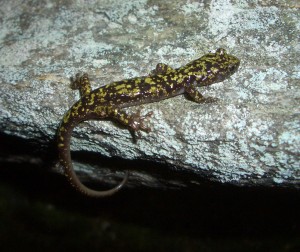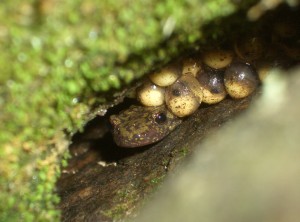For the last year, Alan Cameron, a 7-year volunteer with the North Carolina Wildlife Resources Commission, has been surveying Blue Star’s land for the Green Salamander (Aneides aeneus). This salamander is THE only one of North Carolina’s 66 known species of salamander to be listed as ‘rare and endangered.’
Alan started his work on our camp property while expanding his search from the DuPont State Forest which adjoins our camp (see link). Better understanding this Green Salamander will help state wildlife biologists create more effective conservation methods.
This particular salamander spends most of the Spring and Fall in crevices in rocks. In the Summer most of the population is up in the trees, and in the Winter they are in hibernation deep in the rocks’ crevices.
Usually late in June the gravid females will come down out of the trees and move into the rock crevices where they will lay about 30 eggs which will hang from the crevice roof like a bunch of grapes. The female will stay with the eggs for three months until after they hatch, and it is believed that she does not eat during this period.
Alan has discovered five sites on camp where Green Salamanders are living, and hopes to find a site where campers can see this rare and endangered creature.
This past August, he discovered a site in camp where a female Green Salamander had a nest of eggs, and in ten days all of the eggs had successfully hatched. Attached are photographs of a single adult Green Salamander and a female one with an egg nest she is protecting.
Blue Star appreciates Alan’s efforts on behalf of this endangered Salamander. We should all be encouraged by Alan’s selfless commitment to this gentle creature and to our planet. We know that there are many ways to repair our world and to express reverence for life on earth. Alan has found his way. In this New Year ahead, may we all find ours.
Best wishes for a healthy, happy and peaceful 5772.

